1. Basic stippling and pen method of seal script
Oracle, big seal, and small seal are all seal scripts. The calligraphy materials related to the period from the Yin and Shang Oracle bone inscriptions to the Qin Xiaozhuan period are limited to inscribed inscriptions and stone inscriptions. There is a big gap between this form of writing directly with a brush. There is no discussion about whether the brush pen was used in the pre-Qin period of the bronze inscriptions, but only to say; until now, there are no preserved seal script materials that were directly written by the brush at that time.
Since seal script is an early script, its basic strokes and pen-using methods are not as rich and complex as the official script and regular script that will appear later. As far as the big seal and the small seal are concerned, there are only three brush strokes: point, straight and arc. The basic strokes of seal script and Deng Shiru's method of seal script are introduced as follows:
1. dot
The seal script uses less dots, and is often connected with other strokes, as a part of other strokes, or extended into short horizontal or short vertical. There are fewer individual dots, and the writing method is: start the pen from the center of the dot, rotate from left to right, and move the pen while turning, until it turns into a circle and then close the pen. However, Deng Shiru's points are extremely varied, and the points of the same word in the same work are handled differently. See (Figure 1) the different ways of writing the dots in the three "太" characters.
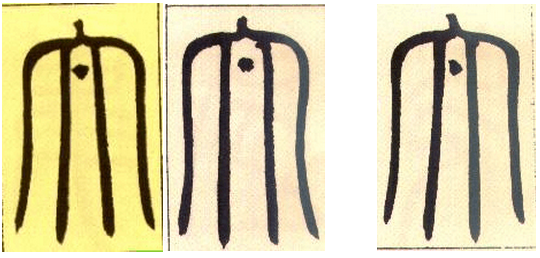
(Picture 1) Different writing styles of the three "太" characters
2. Straight
Straight includes long or short horizontal and vertical. The basic writing method must be reversed; it is to hide the head and protect the tail, the two ends are round, and the thickness of the middle part is the same. There are also a small number of horizontal or vertical ones that are inverted and flat out. Such as (Figure 1) "太" character. The horizontal and vertical lines of Deng Shiru's seal script are not all straight lines. Except for the vertical straight line at the center, the horizontal and vertical lines are often slightly curved. Very dynamic. The brushwork can be seen from the horizontal drawing of "上" and the horizontal drawing of "十" in (Figure 2).
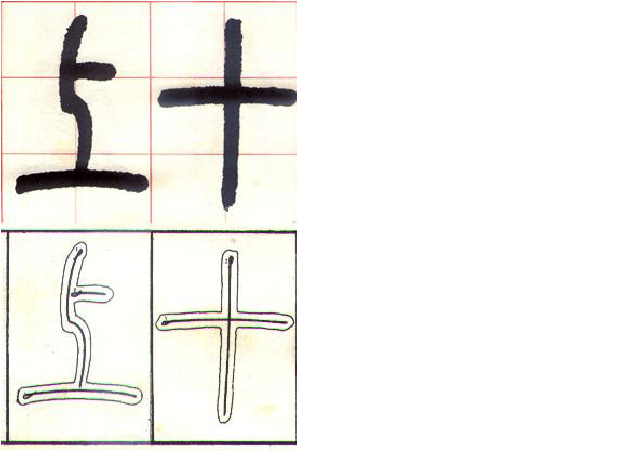
(Figure II) 上十
3. Arc
The arcs in the seal script can be divided into angular arcs, semi-circular arcs, circular arcs, square arcs and irregular arcs. Except for some irregular arcs, arcs are written by two pens. Take circular arcs as an example; pen strokes are basically the same as horizontal or vertical pen strokes. Start with the tribal pen above the circle to be written, and first write a semicircle to the left. Then write a semicircle to the right from the head and tribal pen of the upper stroke, and meet below the circle, leaving no traces at the overlap of the meeting. (Picture 3) The two arcs at the upper part of the Chinese character "大" and the two arcs at the lower part of "Zhu" are both written in two strokes. (Picture 4) The arc above the character "月" is written in two strokes, the arc at the bottom of the character "月" is irregular, and the arc "多" is written in one stroke.
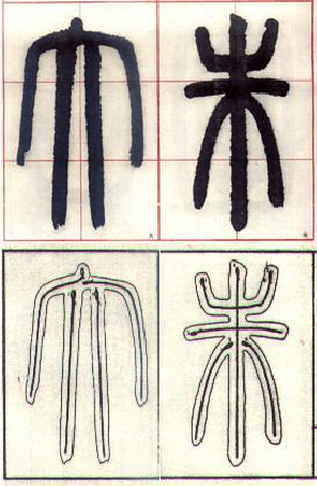
(Picture 3) 大朱
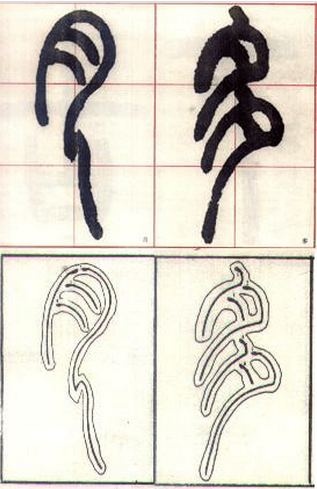
(Picture 4) 月多
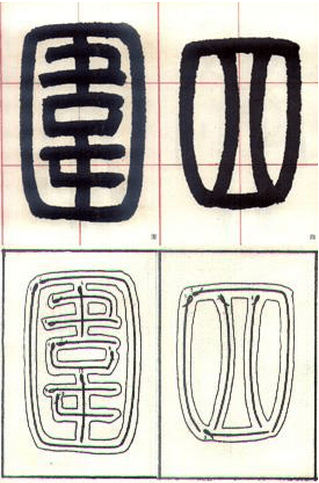
(Picture 5) 围四
(Picture 5) The outlines of the characters "Wei" and "四" can be divided into two strokes or three strokes. Although it is the outer frame, it is also curved. 2. Deng Shiru's method of starting and ending the seal script:
Conversely, pay attention to introverted and reserved; or reverse inward and flat out, relaxed and smooth. Conversely, the two ends of the painting are perfectly rounded, as shown in the two paintings on the upper part of the character "Gong" (Figure 6). Inverted in and flat out, the beginning of the pen is round and thick, and the end of the pen is slightly pointed, such as "too" (Figure 6). However, the collection of seal scripts is still mainly Tibetan, and occasionally reveals the spirit to show the spirit.
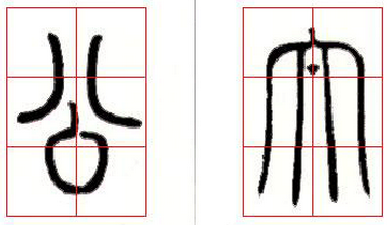
(Picture 6) 公太
Third, the method of pen transport:
In the strokes, you can use the method of lifting and turning to see the smoothness: or use the method of stopping first and then turning, and see the outer circle and the inner square; or use the method of zigzag, and see the square force. (Picture 7) The curved painting on the upper part of the character "Bei" uses the method of stopping first and then turning; the curved painting on the lower part uses the method of lifting and turning. (Picture 7) The tunes and paintings of the character "ji" are mostly used in a sudden fold. However, multiple methods are often used in one word.
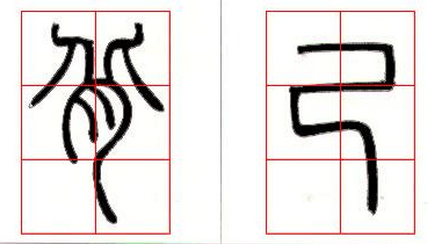
(Picture 7) 背己
Fourth, the processing method of the line relationship:
1. Parallel relationship: The straight lines in the seal script are usually handled in parallel, such as (Figure 8) the horizontal paintings of the character "Yi". These horizontal paintings are not really straight and horizontal, but also arc-shaped horizontally. Parallel methods are sometimes used to process the curve bars in the seal script, such as the upper left and upper right curves of the word "dao" (Picture 8).
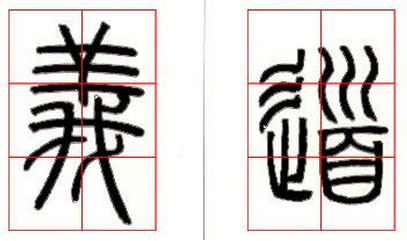
(Picture 8) 义道
2. Hug and contradictory relationship: The curves in seal script are mostly dealt with by hugging and contradictory. For example (Figure 9) "Lai", the curves on the left and right of the middle straight line are all handled with the embrace relationship; while (Figure 9) the curves around the "Empty" are arranged with opposites, in the middle of the word They are often used at the same time as each other, in order to achieve the effect of complementing each other. For example (Figure 10) the outer two curves of the word "and" embrace each other, the inner two curves are opposite each other, and the left two curves and the right two curves respectively form an embrace relationship. (Figure 10) The curves in the lower part of the character "Zhan" constitute the opposite and embrace each other respectively.
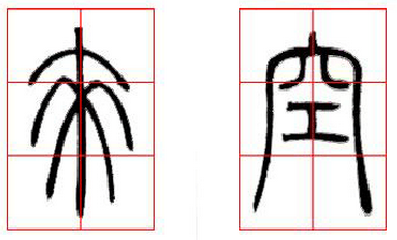
(Picture 9) 来空
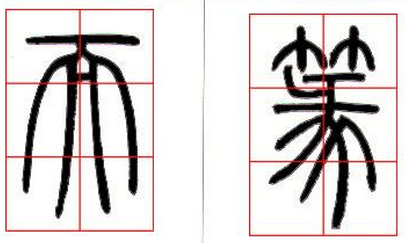
(Picture 10) 而篆
3. Staggered relationship: When there are two or more drooping lines in the seal script, the jagged changes of the feet should be paid attention to. For example (Figure 11) "White", although there are only two hanging feet, there are also differences in height. Another example is (Figure 11) the jagged changes of the four vertical feet in the character "Goose".
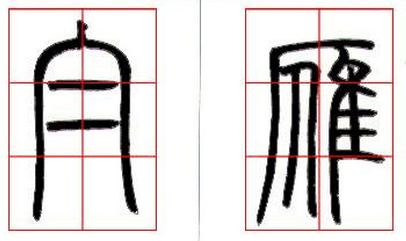
(Picture 11) 白雁
4. Symmetrical relationship: Symmetrical treatment of lines is an important feature of seal script. Such as (Picture 12) "不" and "去"; (Picture 3) "大" and "朱". Although it is symmetrical, it is not absolutely the same on both sides. We can still see the changing and dynamic symmetry.
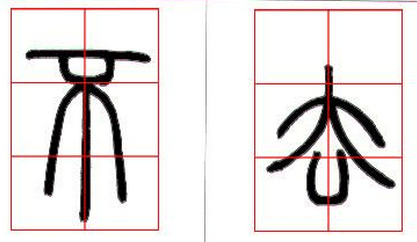
(Picture 12) 不去
Fifth, the method of distributing white
1. Uniformity: Uniformity is the pursuit of the seal script. The method of parallelism and symmetry in the lines is closely related to this. For example (Figure 13), the blanks between the horizontal lines of the word "quantity" and the blanks on the left and right of the center line are almost the same. (Picture 13) The blank spaces at the upper, lower, left, and right of the character "nai" are almost the same.
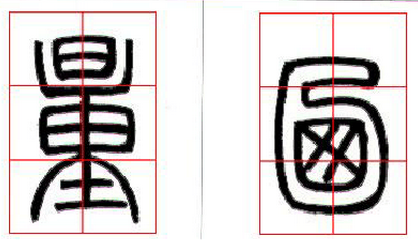
(Picture 13) 量乃
2. Top dense and bottom sparse: In addition to the uniformity of the white space between the lines, the seal script also pays attention to the change of density. In most cases, Xiaozhuan adopts the arrangement method of dense top and sparse bottom. For example (Figure 14), the words "heart" and "huang" are all dense and sparse.
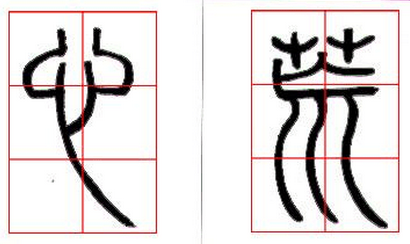
(Picture 14) 心荒
3. Top sparse and bottom dense: In the seal script, the strokes of some characters are stretched upwards. In this case, in addition to the unevenness of the paintings that stretch upwards, the white space is handled with sparse top and bottom dense. method. Such as (Picture 15) "之" and "世".
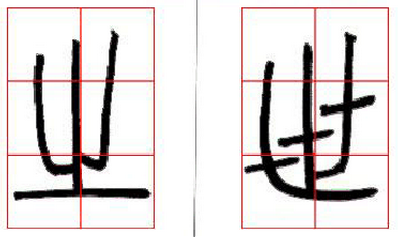
(Picture 15) 之世
6. The method of structure;
1. Let it be: (Picture 16) "Evil" and "stupid" are up-and-down structures, and if they are not handled well, they tend to feel separated from up and down. When handling the structure, the upper part expands outward and the lower part enters, so that the upper and lower parts can be integrated.
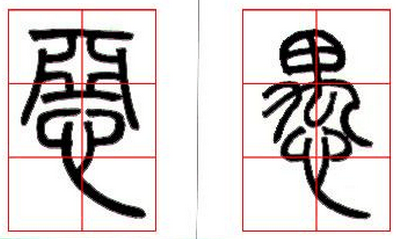
(Picture 16) 恶愚
2. The left is high and the right is low: the left part can only stretch upwards, and the right part stretches downwards, such as the character "Cicada" (Figure 17); or there are paintings stretching upwards and downwards on the left, but the left part can only be downwards Stretching painting, such as "good". In this case, the left and right positions are usually treated as being high on the left and low on the right.
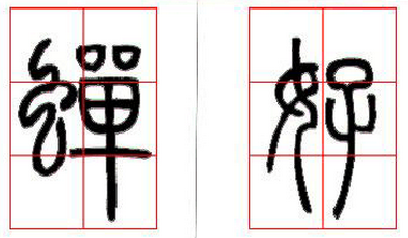
(Picture 17) 蝉好
3. Low left and high right: The left part has only lines that can extend downwards, and the right part has only lines that can extend upwards, such as (Figure 18) "Zhao", or the left part has lines that can extend upwards and downwards, and the right A line that can only stretch upwards, such as the word "物" (Figure 18). Usually, the left and right positions can be arranged as low left and high right.
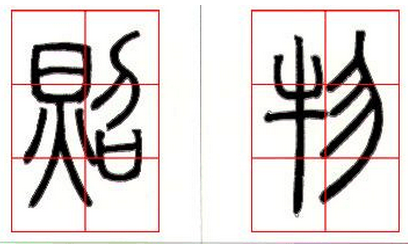
(Picture 18) 照物
4. Left-centered-right: there is no painting stretching up and down on the left, and painting stretching up and down on the right, such as (Figure 19) "Drunk"; or a painting that stretches up and down on both sides, but the left part is slightly smaller than the right part, such as Figure 19) The word "fine". In this case, the left and right positions are usually treated as left-centered.
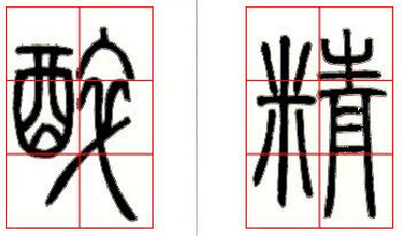
(Picture 19) 醉精
5. Flat top: The left part is small and there are no hanging feet down, and the right part is big and there are hanging feet down. The left and top positions are usually used, such as (Figure 20) "Wei" and "Ming".
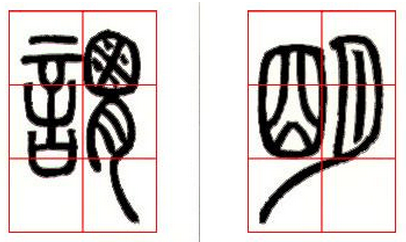
(Picture 20) 谓明
If you encounter a character with a left, middle, and right structure, you should use the position arrangement method flexibly. For example (Figure 21) "Inclination", the left and middle parts adopt the method of living on the left, while the middle and right parts adopt the method of flat. And (Figure 21) "Avoid", the left and middle right parts take the position of high left and low right, and the middle and right parts take the upper level position.
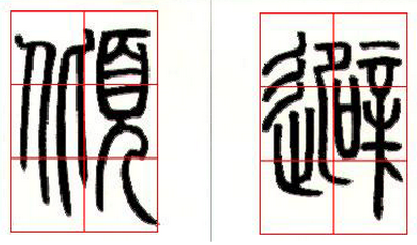
(Picture 21) 倾避
6. The quadrangular shape encloses the entire space: in (Picture 5), the word "surround" and the many horizontal paintings divide the space neatly, so that the blank space becomes comfortable and bright. This is also extremely important in the structure of the seal script. (Picture 5) The two verticals in the "four" in the middle are curved outwards in a back position, in contrast to the vertical paintings on the outside, which are gathered by the horizontal paintings at the bottom, and the brushwork is beautiful and lively.
In summary, the seal script method introduced above is not only the general rule of seal script, but also the seal script method developed by Deng Shiru. Only after understanding each type of seal script can you realize Deng Shiru's true contribution to the development of seal script.








